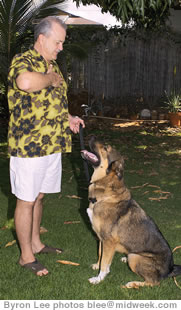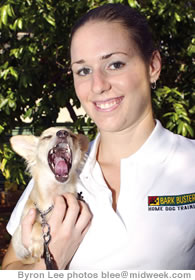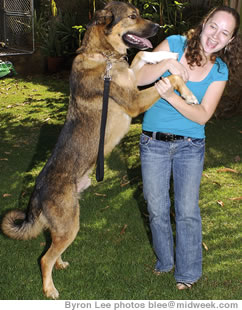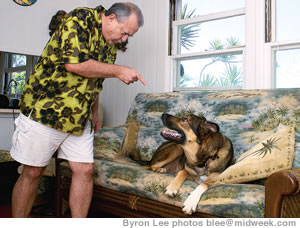No More Bad Dogs
Scott Argus and Bark Buster techniques can change the behavior of bad dogs in one day, and then he gives you and your dog reinforcing homework

Scott Argus gives Rufy hand signals
Visitors to Scott Argus’ home in Kaimuki are promptly greeted by his four-member dog-squad. There’s Rufy, the big giant teddy bear; Chili, the pup of a Queensland healer and Catahoula McNab/border collie mix; Chico, an Australian blue healer, and little Lucky, a fox terrier and Chihuahua mix.
“This is a big dog house,” laughs Argus. “The dogs just let us live here.”
This well-behaved crew of canines can attribute their good manners to Argus’ dog training methods, afterall, their master is also the owner of the local franchise of Bark Busters Home Dog Training.
Argus openly admits he’s “not a business man” by nature, but when it comes to running Bark Busters, everything has just come naturally. The longtime dog lover migrated to Oahu from California in 2000 when he decided to leave behind his career as a biomedical engineer to “be my own boss.” After that, Bark Busters Hawaii was born.

Jodi Erickson and yawning Lucky
As for his “helpers,” Argus is the fourth owner of Rufy, whose full name is Canis Rufus Giganticus (Latin for “big red dog”), once a three-time turn-in at a California Humane Society. Because the Alaskan Malamute and Great
Dane mix had been adopted and taken back so many times, Argus was not allowed to bring Rufy back to the Humane Society, and luckily, he doesn’t want to.
“He’s the Bark Buster demo dog,” says Rufy’s proud dad. “He’s an example of what you can do.”
Besides Rufy, Argus also brought Chili, short for City of Chili Cothe, with him when he made the move to Hawaii. While here, he got Chico from a customer in exchange for training the dog’s mother. Lucky and Chico belong to Argus’ assistant, Jodi Erickson, a senior at UH-Manoa, who’s been working with him for the last six months. Erickson aspires to become a dog trainer and is currently majoring in Resource Management.
Bark Busters training methods help dogs who are nuisance barkers, have aggressive behavior, pull on their leash, toilet in the house, have separation anxiety or other deviant behaviors. The training is also ideal for puppies because the methods accelerate their learning curve in the first four to six months of life.

The author meets Rufy
So how does this dog training business work? Here’s the scoop:
Argus travels to a person’s home for a one-time three hour visit. If a customer has been referred to Bark Busters by their veterinarian, chances are they’ve already filled out a prepared quiz inside the company’s brochure - to give Argus an idea of what their dog needs help with. He then makes a presentation on the Bark Busters system and later works one-on-one with the dog(s) using techniques with voice tones and body language.
“I teach the owner a whole bunch of techniques on how to work with their dog. At the end of the session, I give them a homework package,” he explains.
After his visit, Argus emphasizes the importance of the dog owner following the homework package, which involves working with their dog for 10 to 15 minutes two times a day, for five to eight weeks.
“From then,” says the Ohio native, “the dog will recognize the owner as the ‘leader of the pack.’ It’s basically a new way of dog training.”
The leader of the pack reference comes from studies done by Bark Busters founders Sylvia and Danny Wilson. In 1989, the Australian couple learned there was a poor adoption to euthanasia ratio, that too many animals were being put down at Australian Humane Society branches. No one wanted to adopt dogs because their behavior was out of control, Argus explains.
The Wilsons studied wild dogs and learned that packs of dogs behave according to their leader, the alpha male. Going with the idea that dogs are pack animals with an instinctual way of communicating, the Wilsons’ method of training is to teach through the use of voice tones and body language.

Tone of voice, hand gestures and body language say it all to
dogs
“The techniques are natural,” says Argus. “People see huge changes in their dogs while I’m there the first day.”
Out of the many customers he’s taken care of - currently about 200 - Argus recalls a couple of instances that were a bit different from the rest.
A woman had a dog that bit someone, and the person filed a lawsuit. Argus was able to help her out by going to court appearances with her, to show she was making an attempt to work with her dog. His advice to others who think they could be in this situation: “Don’t wait until it becomes a catastrophe.”
Through their vet, Argus became acquainted with an elderly couple whose Italian mastiff had bitten another dog, badly injuring it. The couple contemplated giving the dog away, but were worried it would wind up in the wrong hands. Their vet suggested that because Mikey was only 2 years old, they should call Argus. Scott then worked with dog for three weeks and saw good results.
“He now lives in a big home in Hawaii Kai,” he says. “He’s a really happy ending.”
To contact Argus, call 734-3440 or check out www.barkbusters.com
Page 1 of 1 pages for this story
E-mail this story | Print this page | Comments (0) | Archive | RSS
Most Recent Comment(s):








